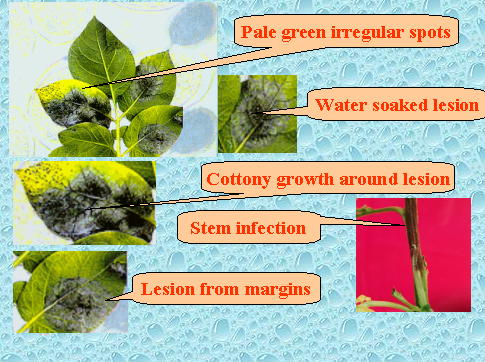

Late blight is caused by a fungus (Phytophthora infestans (Mont.) de Bary). The disease appears first as water- soaked irregular pale green lesions mostly near tip and margins of leaves. These lesions rapidly grow into large brown to purplish black necrotic spots. During morning hours a white mildew can be seen on lower surface of infected leaves especially around the edges of the necrotic lesions. On stems or petiole light to dark brown lesions appears that elongate and encircle the stems. The affected stems or petiole become weak at these locations and may collapse. Under favorable conditions entire crop gives blackened blighted appearance. Tubers in soil become infected by rain borne sporangia from the diseased foliage. The infected tubers show irregular reddish brown to purplish slightly depressed areas that extend deep into internal tissue of the tubers. The infected tubers are initially hard, dry and firm but may be invaded by other pathogens mainly bacteria and turn to soft rot.
Severity of this disease is moderate in subtropics as compared to temperate climates, but heavy losses can occur if proper management practices are not adopted. In India it is most severe in the hills. In the subtropical plains, the disease is generally more regular and severe in north-eastern plains of Bihar, Assam and Orissa as compared to western plains. In hilly regions losses may go as high as 80-90 percent in susceptible potato varieties not protected by fungicides. Losses are generally low in plains where disease does not occur every year. However, in certain years these may go up to 25 per cent.